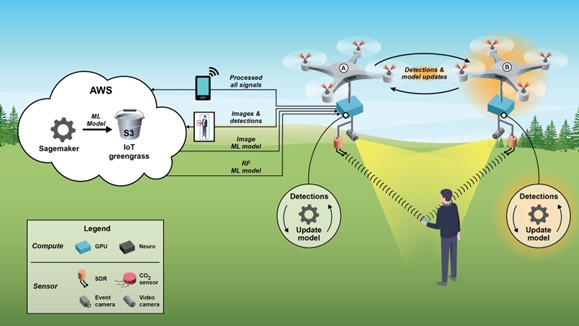Project Thrusts
Security Use Case The CHESS program is testing strategies for building multimodal artificial intelligence (AI) models in the cloud and deploying them on drones. CHESS is optimizing and packaging models for deployment at the edge to address weight, latency, and power constraints that drones commonly face. It is also moving data between cloud and edge, and edge devices. AI-driven software understands the visual and electromagnetic environments for drones, making near-instant decisions. The security thrust is laying a foundation for testing cloud to edge communications for national security missions. |
|
Science Use Case New materials have the potential for improving solar generation, creating new batteries, developing new health care treatments, and enabling new techniques in computing. Both theorists and experimentalists are tackling the problem, but each from different angles. Although theory benefits from experimental measurement and validation, experiments benefit from theory’s guidance and explanations. Accelerating material discovery depends on connecting the benefits of each approach through automation. CHESS’s science thrust is developing the computing and coordination techniques for automating theory-experiment cycles. New methods are needed for representing and executing the computational workflows that are formed between instruments and computational devices ranging from near-instrument devices, high performance computing systems, and specialized demand-driven cloud resources. CHESS’s research is exploring techniques for productive and portable representations, scheduling and resource assignment, diagnosing and removing performance bottlenecks, AI/machine learning methods for domain semantics, and customized data compression to adjust data flow. |
|
 Foundational Cloud CapabilitiesReproducible Research – This CHESS effort enables researchers to capture and archive their cloud-based computational research, and reinitialize it later to continue their work. The dehydration component captures the compute environment, data, and software, and archives them into PNNL-hosted compute spaces. Researchers can then rehydrate these capabilities and continue their research by initiating a compute workload that deploys the environment, code, and data back to the cloud computing environment. Cloud Blueprints – The cloud blueprints effort seeks to simplify the deployment of functional units of cloud-based computing services by providing a single button push for automatic deployment of these services. Currently a researcher must have cloud computing expertise and spend what can be hours or days working to properly set up their cloud computing environment. With a blueprint, the researcher can navigate to their PNNL cloud management page, select the blueprint of interest, and in a button click deploy the blueprint to their cloud subscription. PNNL has developed and operationally deployed an exploratory data analysis blueprint that enables a researcher to explore their data in a cloud computing environment. Future next blueprints will include ones for Machine Learning Operations, natural language processing, and faster data processing. |